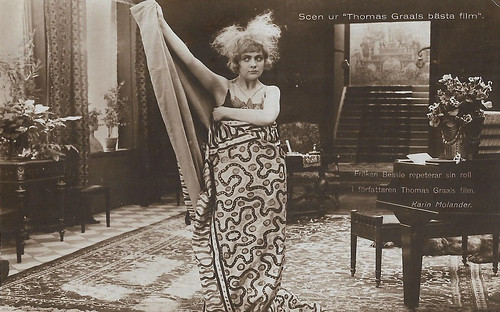
Swedish postcard by Ed. Nordisk Konst, Stockholm, no. 876. Photo: Svenska Biografteatern AB. Karin Molander vamping in Thomas Graals bästa film/Thomas Graal's Best Film (Mauritz Stiller, 1917), scripted by Gustav Molander. The story deals with a screenwriter (Victor Sjöström) who falls in love with his secretary Bessie (Karin Molander) and imagines himself rescuing her from poverty. Reality is quite different as Bessie is a modern woman. The film also mocks the bored aristocracy involved in the modernity of filmmaking. Caption: Miss Bessie is practising her role in the writer Thomas Graal's film.

Swedish postcard by Nordisk Konst, Stockholm, no. 1078/9. Photo: Svenska Biografteatern. Mary Johnson in Herr Arnes pengar/Sir Arne's Treasure (Mauritz Stiller, 1919). Caption: The next day the dream did not leave Elsalill's mind.
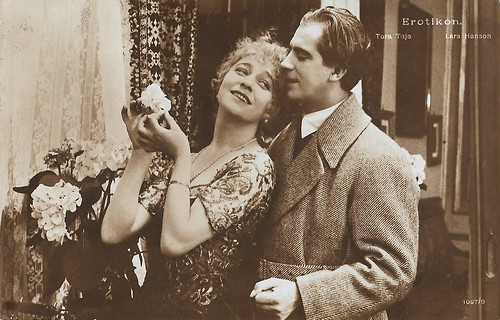
Swedish postcard by Nordisk Konst, Stockholm, no. 1097/9. Tora Teje and Lars Hanson in Erotikon (Mauritz Stiller, 1920).
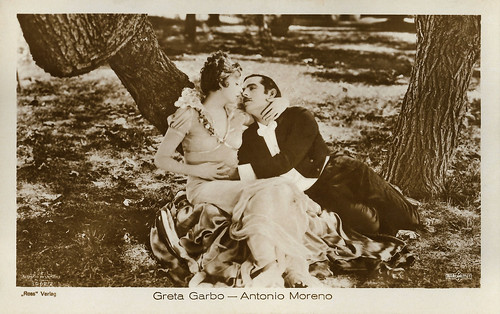
German postcard by Ross Verlag, no. 3062/2, 1928-1929. Photo: Metro-Goldwyn-Mayer / Parufamet. Greta Garbo and Antonio Moreno in The Temptress (Fred Niblo, Mauritz Stiller, 1926).
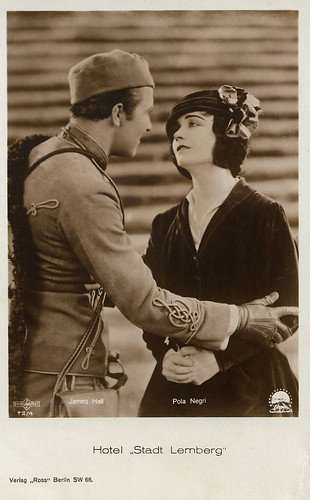
German postcard by Ross Verlag, Berlin, no. 72/4. Photo: ParUfaMet / Paramount. James Hall and Pola Negri in Hotel Imperial (Mauritz Stiller, 1927). The German film title was Hotel "Stadt Lemberg".
Involved with Sweden's rapidly developing silent film industry
Mauritz Stiller was born Moshe Stiller in Helsingfors (now Helsinki) in 1883. He was one of the six children of Hirsch Stiller and his wife Mindel (née Weissenberg). His family was of Ashkenazi Jewish heritage. Before settling in Finland, they had lived in Russia and Poland, then part of the Russian Empire.
After his father's death when he was four, his mother committed suicide. A family friend, the tailor Peretz Katsman, raised him and Mauritz began working for him at the age of 13. From an early age, Stiller was interested in acting. His talents did not go unnoticed, and soon Stiller got the opportunity to practice and display his acting skills in the Folkteatern of Helsingfors and other theatres in Finland.
Finland was at the time an autonomous Grand Duchy of Finland, part of Russia, and Stiller was drafted into the army of Czar Nicholas II. Rather than report for duty he fled the country for exile and settled in Sweden. He became a Swedish citizen in 1921. By 1912, Stiller had become involved with Sweden's rapidly developing silent film industry.
Together with actor-director Viktor Sjöström, he was recruited as a director and actor in the Swedish film industry by Charles Magnusson at AB Svenska Biografteatern. Stiller began by writing scripts, acting, and directing short films and was immediately successful. Soon he gave up acting to devote his time to writing and directing.
During 1912-1916 he directed no less than 34 films, in different genres. The most remarkable early film was Vingarne/The Wings (1916), an adaptation of Danish writer Herman Bang’s novel ‘Mikael’. Stiller added a framing structure to the story, showing the production of the film itself and how it is received by critics and the audience.
This self-reflexive element is also present in Stiller’s comedies Thomas Graals bästa film/Thomas Graal’s Best Film (1917) and Thomas Graals bästa barn/Thomas Graal’s Best Child (1918), both starring Victor Sjöström in the title role opposite Karin Molander. Both films received much acclaim and were very popular.
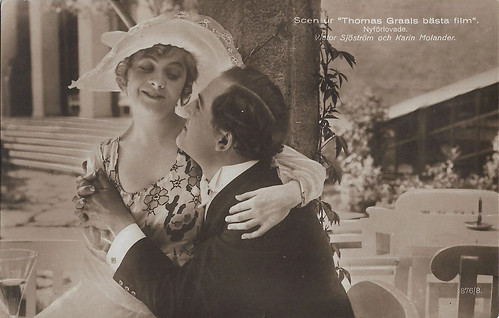
Swedish postcard by Ed. Nordisk Konst, Stockholm, no. 876/8. Photo: Svenska Biografteatern AB. Publicity still for Thomas Graals bästa film/Thomas Graal's Best Film (Mauritz Stiller, 1917), scripted by Gustav Molander. The story deals with a screenwriter (Victor Sjöström) who falls in love with his secretary Bessie (Karin Molander) and imagines himself rescuing her from poverty. Reality is quite different as Bessie is a modern woman. The film also mocks the bored aristocracy involved in the modernity of filmmaking. Caption: The newly engaged ones.

Swedish postcard by Nordisk Konst, Stockholm, no. 877/1. Photo: Svenska Biografteatern AB. Hauk Aabel and Stina Stockenstam in the comedy Alexander den Store/Alexander the Great (Mauritz Stiller, 1917) with . The story of the film deals with a provincial hotel cook, named Alexander the Great, in whose restaurant not only the dishes can be spicy. Caption: Alexander has rediscovered his beloved from his youth.

Swedish postcard by Förlag Nordisk Konst, Stockholm, no. 961. Photo: Svenska Biografteatern. Victor Sjöström and Karin Molander in the comedy Thomas Graals bästa barn/Thomas Graal's First Child (Mauritz Stiller, 1918).
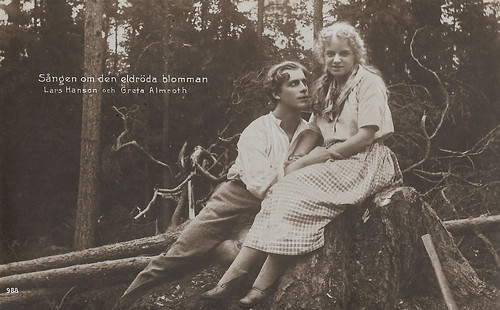
Swedish postcard by Forlag Nordisk Konst, Stockholm, no. 988. Photo: Svenska Biografteatern, Stockholm. Lars Hanson and Greta Amroth in Sången om den eldröda blomman/Song of the Scarlet Flower (Mauritz Stiller, 1919).
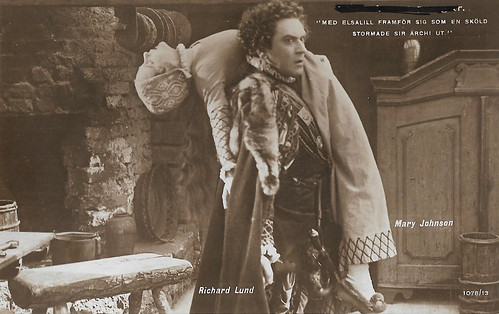
Swedish postcard by Nordisk Konst, Stockholm, no. 1078/3. Photo: Svenska Biografteatern. Richard Lund and Mary Johnson in Herr Arnes pengar/Sir Arne's Treasure (Mauritz Stiller, 1919). Caption: With Elsallil before him like a shield, Sir Archi stormed out.
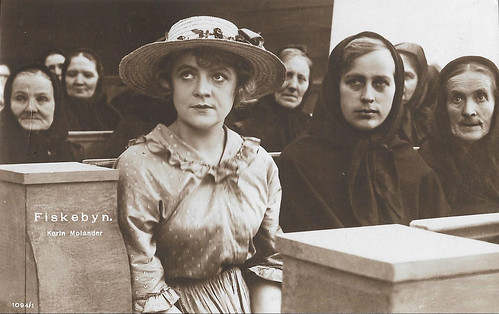
Swedish postcard by Förlag Nordisk Konst, Stockholm, no. 1094/1. Photo: Svenska. Karin Molander in Fiskebyn/Chains/The Fishing Village (Mauritz Stiller, 1920).

Swedish postcard by Nordisk Konst, Stockholm, no. 1097/2. Anders de Wahl and Karin Molander in Erotikon (Mauritz Stiller, 1920).

Swedish postcard by Ed. Axel Eliassons Konstförlag, Stockholm, no. 293. Photo: Skandia Film, Stockholm. Jenny Hasselquist in De landsflyktiga/The Emigrants/The Exiles (Mauritz Stiller, 1921). This is a lost film, except for a few very short fragments.
Continuing disagreements with Hollywood studio executives
By 1920, Mauritz Stiller was a leading figure in Swedish filmmaking. His masterpieces were the Selma Lagerlöf adaptation Herr Arnes pengar/Sir Arne's Treasure (1919) with Richard Lund and Mary Johnson and the stylish comedy Erotikon (1920) with Tora Teje and Lars Hanson.
Jon Wengström writes in The Swedish Film Database: “The characteristic trait in Swedish silent films at the time, the interaction between Man and Nature, was taken to new heights by Stiller in Sången om den eldröda blomman/Song of the Scarlet Flower (1919) and Johan (1921). Both films were shot on location in northern Sweden, and both had spectacular downstream log-riding sequences as dramatic climaxes.”
He also directed Gunnar Hedes saga/Snowbound (1923) starring a young Einar Hanson and based on the Selma Lagerlöf novel ‘En herrgårdssägen’. At the Royal Dramatic Theatre in Stockholm, he met a young actress named Greta Gustafsson whom he cast in an important but secondary role in his film, Gösta Berlings saga/The Atonement of Gosta Berling (1924), featuring Lars Hanson and also a Selma Lagerlöf adaptation.
In 1924, Mauritz Stiller planned to shoot a film in Turkey titled The Odalisque from Smyrna and hired Conrad Veidt and Einar Hanson as stars. Along with Hansen and protégée Greta Gustafsson, Stiller left for Istanbul but the promised financing vanished. They moved to Germany, where Greta appeared in Die Freudlose Gasse (G.W. Pabst, 1925). Then they sailed with Einar Hanson off to the USA.
Stiller had accepted an offer from Louis B. Mayer to direct for Metro-Goldwyn-Mayer. In Hollywood, MGM assigned Stiller to direct Greta Gustafsson as Greta Garbo in her second American film, The Temptress (1926), but he could not deal with the studio structure. After repeated arguments with studio executives, MGM replaced him on the film with Fred Niblo and terminated his contract with the studio.
Paramount Pictures immediately hired Stiller. He made three successful films, The Woman on Trial (1927), Hotel Imperial (1927) and Barbed Wire (1927), all starring Pola Negri. Then Stiller was let go a second time while directing his fourth film, The Street of Sin (1928), starring Emil Jannings and Fay Wray, because of his continuing disagreements with studio bosses.
Mauritz Stiller returned to Sweden in 1927 and died the following year from pleurisy at the age of 45. Garbo was devastated when she heard the news. He was interred in the Norra begravningsplatsen in Stockholm. Mauritz Stiller directed 51 silent films and appeared as an actor in seven productions from 1912 to 1927. In 1960, Hollywood recognised Stiller's contribution to the motion picture industry with a star on the Hollywood Walk of Fame at 1713 Vine Street. Originally his star was listed erroneously as "Maurice Diller" but it was finally corrected in the late 1980s. In Kristianstad, a monument was erected in his honour.
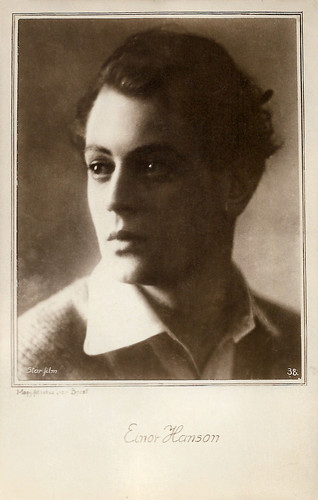
Hungarian postcard by Magy. fot. soksz ipar, Budapest, no. 38. Photo: Starfilm. Einar Hanson in Gunnar Hedes saga/Snowbound (Mauritz Stiller, 1923).

German postcard. Photo: Svenska Film of the Trianon-Film-Konzern, Berlin (also in Leipzig, Frankfurt a.M., Düsseldorf and Hamburg). Lars Hanson in Gösta Berlings saga/The Saga of Gösta Berling (Mauritz Stiller, 1924). The film was an adaptation of the famous novel by Selma Lagerlöf. The cinematography was by Julius Jaenzon, and the art direction was by Vilhelm Bryde (with Edgar Ulmer collaborating on the set design). This postcard was made by Trianon for the German premiere of the film on 20 August 1924, at the Berlin Theater am Nollendorfplatz.

German postcard by Ross Verlag, Berlin, no. 72/1. Photo: Parufamet / Paramount. Pola Negri in Hotel Imperial (Mauritz Stiller, 1927).

German postcard by Ross Verlag, no. 3993/1, 1928-1929. Photo: Paramount. Fay Wray in Street of Sin (Mauritz Stiller, 1928).

French postcard by Europe, no. 344. Emil Jannings in The Street of Sin (Mauritz Stiller, 1928).
Sources: Jon Wengström (The Swedish Film Database), Ulf Kjell Gür (IMDb), Sandra Brennan (AllMovie), Wikipedia (English and Swedish), and IMDb.
2 comments:
Thank you. Very beautiful. I guess they wouldn’t have made postcards from the movie that Stiller and Garbo were going to make in Constantinople because the film was cancelled due to a lack of funding. Thank you for the writing.
Thanks Scott. We sure would love to find postcards of that film!
Post a Comment